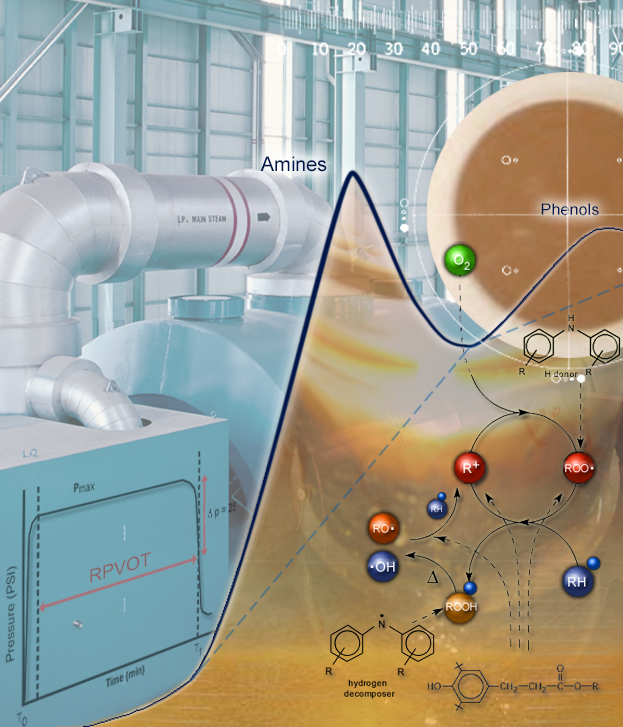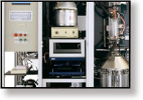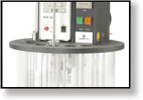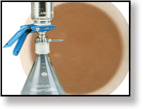Assessing Oxidation Condition and Lubricant Refreshment in Turbine Oils
Turbines are critical pieces of equipment for power plants and related industries. Varnish formatio...

In today's world companies rely on turbines and compressors to provide power and gas transportation for core processes. Turbines and compressors already have demanding lubrication requirements and those demands are increasing. More demands are being put on these fluids as reservoir size and working clearances decrease and system power outputs, pressures, temperatures and oil service life increase. Lubricants must be highly oxidative and thermally stable to be able to handle high operating temperatures. Additionally the lubricant must remain contaminant free to properly lubricate bearings and gears, and to act as a favourable hydraulic medium for governors and valving systems.
Oil oxidation and sludge will lead to sticking servo valves meaning turbines will not start on demand. Oil contamination will accelerate wear, cause governors and valves to operate erratically and plug system filters. Unmonitored, poor oil condition leads to unplanned outages which are extremely expensive. Besides repair and maintenance companies may have to purchase power off the power grid at costs exceeding $50,000 per day.
In order to achieve peace of mind on the operating condition of your turbine and compressor lubricants you need the comprehensive testing that WearCheck Advanced Oil Monitoring provides. Specifically designed for industrial turbines and compressors, WearCheck's advanced oil monitoring combines well established industry tests with more recent advances in industry testing to provide an unparalleled view of the operating condition of your critical lubricants.
WearCheck's Advanced Oil Monitoring™ determines the levels of remaining anti-oxidants in the oil, detects for unwanted oil contamination and will accurately determine the suitability of the lubricant for continued use. A comprehensive diagnosis will warn you of any potential for damaging varnish build-up and includes recommendations for any necessary maintenance actions to remove contaminants and restore the lubricant to proper operating conditions.
WearCheck's Advanced Oil Monitoring™ is intended for use with gas, steam, hydro-electric and aero derivative turbines and large reciprocating and rotary compressors.
| Test | Test Method | Description | AOM 1 | AOM 2 | AOM 3 |
|---|---|---|---|---|---|
 |
ICP Analysis ASTM D5185 |
Determines the parts per million (ppm) of all wear metals (Fe, Cr, Ni, Pb, Cu…), contaminants (Si, Na, K….), and additives (Ca, P, Zn, Mg, Mo…). | |||
 |
Viscosity ASTM D445/D7279 |
Determine the viscosity of the oil at 40°C (non-engine), or 100°C (engine) to determine if oil is still within specification. High viscosity can indicate oxidation, low viscosity can indicate contamination, improper make-up oil. | |||
 |
Visual Screen WC Method |
A picture of both the oil color/clarity and the bottom of the sample bottle are taken, and any level of contamination, visual oil problems or visible wear debris of the oil is recorded. | |||
 |
Acid Number ASTM D664/D974/D8045 |
Determines overall acidity (AN) of the oil which is an indication of degradation. Single best test to determine change-out interval. AN for non-engine oil samples. | |||
 |
Water Content ASTM D6304 |
Determines level of moisture or water contamination in the oil. | |||
 |
Particle Count ASTM D7647 |
Determine cleanliness levels of oil to ISO4406:1999. High particle count levels can indicate gross contaminant ingress, wear, filter by-pass or all of these issues. | |||
 |
Membrane Patch Colorimetry ASTM D7843 |
Measures the relative amount of insolubles present in the oil and the resulting potential for sludge and varnish formation. | |||
 |
Voltammetry (RULER) ASTM D6810/6971/D7527/D7590 |
Measures the levels of aminic and phenolic anti-oxidants remaining in the oil. Determines the necessity for oil replenishment or replacement. | |||
 |
Ferrography ASTM D7690 |
A detailed morphological analysis of the wear debris particles suspended in the oil. A-Ferr can determine the type of wear process and cause of wear in a lubricated system. | |||
 |
RPVOT ASTM D2272 |
Rotating Pressure Vessel Oxidation Test stresses the oil to determine the remaining amounts of anti-oxidants present in the oil. | |||
 |
Foaming Characteristics ASTM D892 |
Multi-stage test (stages I, II, III for both foaming tendency and stability) Determines the oils tendency to entrap air and cause oil foaming as well as the ability of the oil to dissipate this foaming tendency (stability). | |||
 |
Air Release ASTM D3427 |
Provides a comparison of the ability of oils to separate entrained air under operational conditions. Determines if the oil will shed air during reservoir dwell time. | |||
 |
Water Separability ASTM D1401 |
Measures the oils ability to separate from water. | |||
 |
ASTM Color ASTM D1500 |
Determines the ASTM color of the oil product. Indication of the degree of oil refinement and useful in determining when the oil is grossly contaminated, oxidized or thermally degraded. | |||
 |
Rust Test ASTM D665(A) |
Indicates how well the oil inhibits the formation of rust in the presence of water contamination. | |||
 |
Sediment Test ASTM D893 |
Directly measure the amount of insolubles present in the oil. Provides a determination of the amount of sludge forming materials present in the oil (varnish and shellac pre-cursors). |
Check with your local WearCheck laboratory regarding which specific ASTM test methods are utilized.

Turbines are critical pieces of equipment for power plants and related industries. Varnish formatio...
How to properly prepare your samples for return to the WearCheck laboratory using the new QR-coded sample information forms and poly pack mailer.
Membrane Patch Colorimetry (MPC) is a test that can determine the varnish potential of your oil by measuring the amount of insolubles present. Insolubles in oil eventually drop out of suspension and form sticky varnish and sludge in the system and on critical components which can lead to machine failure or outages.
Sales brochure on Advanced Oil Monitoring (AOM) for turbines and industrial compressors....

In this Technical Bulletin we discuss the treatment of varnish deposits in turbine oil, control valv...

This Technical Bulletin discusses a variety of turbine sample tests - how they are conducted, and wh...
WearCheck Aom Analysis includes everything to set-up a complete Aom analysis program. When you purchase a WearCheck Aom analysis program you will receive our simplified sample kits (QR-coded bottles & sample forms with mailing packs). All WearCheck Aom analysis programs include laboratory testing, sample diagnosis and recommendations, sample report, and access to our patented WebCheck™ system, and companion mobile application to manage your Aom analysis program.
WearCheck offers additional programs for Fleet Vehicles, Off-Road Construction, Mobile Equipment, Fixed Plant Machinery, Marine Equipment, Wind Turbine Industry, Aviation/Avionics Systems, Coolant Analysis, Diesel/Marine/Jet Fuel Analysis, Thermal/Heat Transfer Fluid Analysis, Transformer Fluid Analysis, Grease Analysis, Wear Particle Analysis, Honeywell TPE-331/TFE-731 SOAP Service.